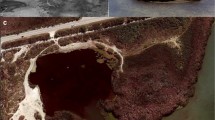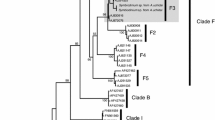Abstract
Kleptoplastic, sacoglossan sea slugs are some of the best known examples of specialist marine herbivores. However, while their chloroplast symbiosis (kleptoplasty) has been studied in many species, little is known about sacoglossan life histories or their seasonal and temporal variation in natural populations. Most sacoglossan species are associated with one or a few closely related algal species that provide the chloroplast source for the kleptoplastic association. Elysia papillosa, a small sacoglossan with a distribution ranging throughout the Caribbean to Florida, primarily feeds on the alga, Penicillus capitatus, although it has also been found on several additional species of algae. A yearlong field survey of E. papillosa in a rhizophytic algal bed in Tarpon Springs, FL, USA revealed a low density of slugs throughout the year except during April, when mean density sharply peaked to 7.0 ± 5.9 slugs (0.25 m2)−1 . Slugs were not found on any algae other than P. capitatus, except occasionally on P. lamourouxii, suggesting that the latter alga serves as a secondary chloroplast source for E. papillosa. The presence of slugs throughout the year implies a broad tolerance of both salinity and temperature although the peak numbers in April may indicate a physiological preference for warming spring temperatures and, perhaps, day length.



Similar content being viewed by others
References
Ali JG, Agrawal AA (2014) Asymmetry of plant-mediated interactions between specialist aphids and caterpillars on two milkweeds. Funct Ecol 28:1404–1412
Baumgartner FA, Motti CA, de Nys R, Paul NA (2009) Feeding preferences and host associations of specialist marine herbivores align with quantitative variation in seaweed secondary metabolites. Mar Eco Prog Ser 396:1–12
Bedinger L (2012) The ecological role of rhizophytic green algae in soft-bottom habitats. Dissertation. University of South Florida
Bedinger LA, Bell SS, Dawes CJ (2013) Rhizophytic algal communities of shallow, coastal habitats in Florida: components above and below the sediment surface. Bull Mar Sci 89:437–460
Christa G, Händeler K, Schäberle TF, König GM, Wägele H (2014) Identification of sequestered chloroplasts in photosynthetic and non-photosynthetic sacoglossan sea slugs (Mollusca, Gastropoda). Front Zool 11:15. https://doi.org/10.1186/1742-9994-11-15
Clark KB (1975) Nudibranch life cycles in the Northwest Atlantic and their relationship to the ecology of fouling communities. Helgoländer wis Meeresunters 27:28–69
Clark KB (1984) New records and synonymies of Bermuda opisthobranchs (Gastropoda). Nautilus 98:85–97
Clark KB, Defreese D (1987) Population ecology of Caribbean Ascoglossa (Mollusca: Opisthobranchia): a study of specialized algal herbivores. Am Malacol Bull 5(2):259–280
Curtis NE, Massey SE, Pierce SK (2006) The symbiotic chloroplasts in the sacoglossan Elysia clarki are from several algal species. Invertebr Biol 125:336–345
Curtis NE, Schwartz JA, Pierce SK (2010) Ultrastructure of sequestered chloroplasts in sacoglossan gastropods with differing abilities for plastid uptake and maintenance. Invertebr Biol 129:297–308
Curtis NE, Middlebrooks ML, Schwartz JA, Pierce SK (2015) Kleptoplastic sacoglossan species have very different capacities for plastid maintenance despite utilizing the same algal donors. Symbiosis 65:23–31
Demes KW, Bell SS, Dawes CJ (2009) The effects of phosphate on the biomineralization of the green alga, Halimeda incrassata (Ellis) lam. J Exp Mar Biol Ecol 374:123–127
Demes KW, Littler MM, Littler DS (2010) Comparative phosphate acquisition in giant-celled rhizophytic algae (Bryopsidales, Chlorophyta): fleshy vs. calcified forms. Aquat Bot 92:157–160
Gavignon M, Mollo E, Montanaro D, Ortea J, Cimino G (2000) Chemical studies of Caribbean sacoglossans: dietary relationships with green algae and ecological implications. J Chem Ecol 26:1563–1578
Goodheart JA, Ellingson RA, Vital XG, Galvão Filho HC, McCarthy JB, Medrano SM, Bhave VB, García-Méndez K, Jiménez LM, López G, Hoover CA, Awbrey JD, De Jesus JM, Gowacki W, Krug PJ, Valdés A (2016) Identification guide to the heterobranch sea slugs (Mollusca: Gastropoda) from Bocas del Toro, Panama. Mar Biodivers Rec 9:56
Gowacki WA, Bell SS, Pierce SK (2016) Correcting taxonomic confusion for the kleptoplastic sea slug Elysia papillosa Verrill (1901). Am Malacoll Bull 34:85–91
Händeler K, Wägele H, Wahrmund U, Rüdinger M, Knoop V (2010) Slugs’ last meals: molecular identification of sequestered chloroplasts from different algal origins in Sacoglossa (Opisthobranchia, Gastropoda). Mol Ecol Resour 10:968–978
Jensen KR (1980) A review of sacoglossan diets, with comparative notes on radular and buccal anatomy. Malacoll Rev 13:55–77
Jensen KR (1983) Factors affecting feeding selectivity in herbivorous Ascoglossa (Mollusca: Opisthobranchia). J Exp Mar Biol Ecol 66:135–148
Jensen KR (1993) Morphological adaptations and plasticity of radular teeth of the Sacoglossa ( = Ascoglossa) (Mollusca: Opisthobranchia) in relation to their food plants. Biol J Linn Soc 48:135–155
Jensen KR (1994) Behavioural adaptations and diet specificity of sacoglossan opisthobranchs. Ethol Ecol Evol 6:87–101
Jensen KR (1997) Evolution of the Sacoglossa (Mollusca, Opisthobranchia) and the ecological associations with their food plants. Evol Ecol 11:301–335
Krug PJ, Vendetti JE, Valdés A (2016) Molecular and morphological systematics of Elysia Risso, 1818 (Heterobranchia: Sacoglossa) from the Caribbean region. Zootaxa 4148(1):137
Long JD, Hamilton RS, Mitchell JL (2007) Asymmetric competition via induced resistance: specialist herbivores indirectly suppress generalist preference and populations. Ecology 88:1232–1240
Marcus E, Marcus E (1967) American opisthobranch mollusks. Stud Trop Oceanogr 6:1–137
Middlebrooks ML, Bell SS, Curtis NE, Pierce SK (2014) Atypical plant-herbivore association of algal food and kleptoplastic sea slug (Elysia clarki) revealed by DNA barcoding and field surveys. Mar Biol 161:1429–1440
Ortea J, Caballer M, Moro L, Espinosa J (2005) Elysia papillosa Verrill, 1901 y Elysia patina Marcus, 1980, (Mollusca: Sacoglossa: Elysiidae) dos nombres para cuatro especies. Vieraea 33:495–514
Pierce SK, Curtis NE (2012) Cell biology of the chloroplast symbiosis in sacoglossan sea slugs. Int Rev Cell Mol Biol 293:123–148
Pierce SK, Warren MK, West HH (1983) Non-amino acid mediated volume regulation in an extreme osmoconformer. Physiol Zool 56:445–454
Pierce SK, Maugel TK, Rumpho ME, Hanten JJ, Mondy WL (1999) Annual viral expression in a sea slug population: life cycle control and symbiotic chloroplast maintenance. Biol Bull 197:1–6
Pierce SK, Curtis NE, Middlebrooks ML (2015) Sacoglossan Sea slugs make routine use of photosynthesis by a variety of species-specific adaptations. Invertebr Biol 134:103–115
Pierce SK, Mahadevan P, Massey SE, Middlebrooks ML (2016) A preliminary molecular and phylogenetic analysis of the genome of a novel endogenous retrovirus in the sea slug Elysia chlorotica. Biol Bull 231(3):236–244
Poore AGB, Hill NA, Sotka EE (2007) Phylogenetic and geographic variation in host breadth and composition by herbivorous amphipods in the family Ampithoidae. Evolution 62:21–38
R Development Core Team (2013). R: A language and environment for statistical computing R Foundation for Statistical Computing Version 3.1.3
Rasher DB, Stout EB, Engel S, Shearer TL, Kubanek J, Hay ME (2015) Marine and terrestrial herbivores display convergent chemical ecology despite 400 million years of independent evolution. Proc Natl Acad Sci U S A 112:12110–12115
Trowbridge CD (1992) Phenology and demography of a marine specialist herbivore: Placida dendritica (Gastropoda: Opisthobranchia) on the central coast of Oregon. Mar Biol 114:443–452
Trowbridge CD, Todd CD (2001) Host-plant change in marine specialist herbivores: ascoglossan sea slugs on introduced macroalgae. Ecol Monogr 71:219–243
Trowbridge CD, Hirano YM, Hirano YJ (2009) Interaction webs of marine specialist herbivores on Japanese shores. J Mar Biol Assoc UK 89:277–286
Verrill AE (1901) Additions to the fauna of the Bermudas from the Yale expedition of 1901, with notes on other species. Trans Conn Acad Arts Sci 11:15–62
West, HH (1979) Chloroplast symbiosis and the development of the ascoglossan opisthobranch Elysia chlorotica. Ph. D. dissertation, Northeastern University, Boston
West HH, Harrigan J, Pierce SK (1984) Hybridization of two populations of a marine opisthobranch with different developmental patterns. Veliger 26:199–206
Acknowledgements
The data reported here were collected by William Gowacki and used in his Master of Science thesis at the University of South Florida. We thank Ashley Peiffer and Rachel Moline for assistance with the fieldwork. We also thank Taegan McMahon for assistance with analysis in R. Finally, we thank a private donor, who wishes to remain anonymous, for providing funds to Sidney Pierce used in this study.
Author information
Authors and Affiliations
Corresponding author
Rights and permissions
About this article
Cite this article
Middlebrooks, M.L., Gowacki, W.A., Bell, S.S. et al. Annual occurrence and algal preferences of the kleptoplastic sea slug, Elysia papillosa. Symbiosis 77, 217–224 (2019). https://doi.org/10.1007/s13199-018-00592-1
Received:
Accepted:
Published:
Issue Date:
DOI: https://doi.org/10.1007/s13199-018-00592-1




